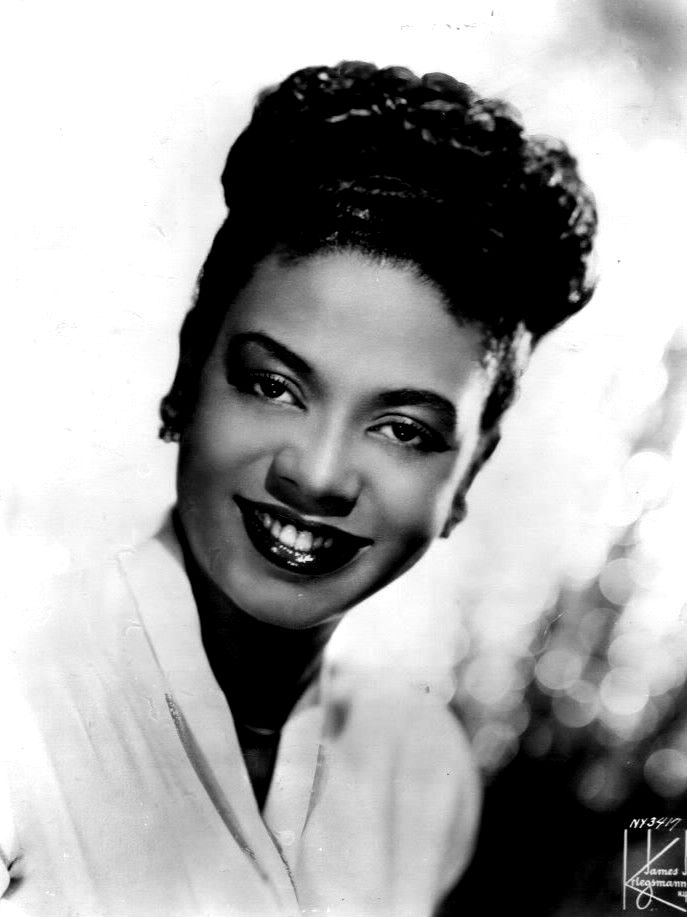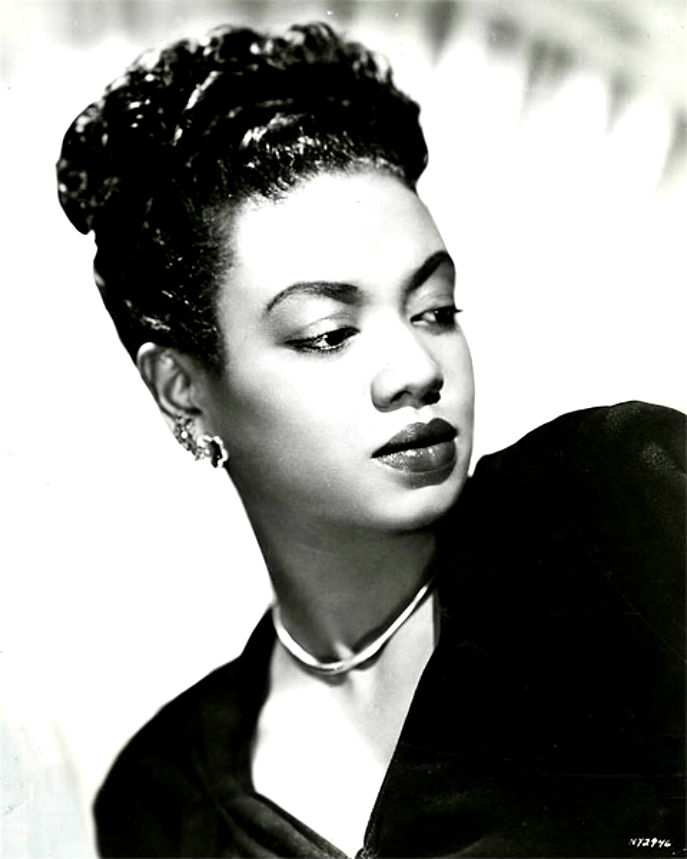 Hazel Scott, June 11, 1920 – October 2, 1981. She was called the “Darling of Café Society” back in 1939 when Harlem New York was alive with the sounds of swing.
Hazel Scott, June 11, 1920 – October 2, 1981. She was called the “Darling of Café Society” back in 1939 when Harlem New York was alive with the sounds of swing.
A sexy siren sitting bare-shouldered at the piano, Hazel Scott captivated audiences with her renditions of classical masterpieces by Chopin, Bach and Rachmaninoff.Nightly, crowds would gather at Café Society, New York’s first fully integrated nightclub, the epicenter of jazz and politics nestled in Greenwich Village, to hear the nineteen-year-old bronze beauty transform “Valse in D-Flat Major”, “Two Part Invention in A-Minor,” and “Hungarian Rhapsody No. 2” into highly syncopated sensations. “But where others murder the classics, Hazel Scott merely commits arson,” wrote TIME magazine. “Strange notes creep in, the melody is tortured with hints of boogie-woogie, until finally, happily, Hazel Scott surrenders to her worse nature and beats the keyboard
Born in Port of Spain, Trinidad on June 11, 1920, Hazel Dorothy Scott was the only child of R. Thomas Scott, a West African scholar from Liverpool, England and Alma Long Scott, a classically-trained pianist and music teacher. A precocious child who discovered the piano at the age of 3, Hazel surprised everyone with her ability to play by ear. When she would scream with displeasure after one of Alma’s students hit a wrong note, no one in the household recognized the sensitive ear she possessed. “They had been amused, but no one regarded my urge as latent talent,” she recalled. Until one day, young Hazel made her way to the piano and began tapping out the church hymn, “Gentle Jesus”, a tune her grandmother Margaret sang to her daily at nap time. From that moment on, Alma shifted her focus from her own dreams of becoming a concert pianist, and dedicated herself to cultivating her daughter’s natural gift. They were a tight knit pair, sharing an extremely close bond throughout their lives. “She was the single biggest influence in my life,” Hazel said. Her father, on the other hand, would soon leave the family and have a very small presence in his daughter’s life.
Following the breakup of the Scott’s marriage, the three of them—mother, daughter and grandmother—would migrate to the States in search of greater opportunity for themselves and the gifted young pianist. In 1924, they headed to New York and landed in Harlem, where Alma took a job as a domestic maid.

She struggled, however, and returned to what she knew best—music. She taught herself the saxophone, and eventually joined Lil Hardin Armstrong’s orchestra in the early 1930s. Alma’s associations with well-known musicians made the Scott household “a mecca for musicians,” according to Hazel, who benefited from the guidance and tutelage of jazz greats Art Tatum, Lester Young and Fats Waller, all of whom she considered to be like family.
In 1928, Hazel auditioned for enrollment in the prestigious Juilliard School of Music. She was only eight-years-old, and too young for standard enrollment (students had to be at least 16), but because of some influential nudging by wealthy family friends and Alma’s sheer determination, Hazel was given a chance. Her performance of Rachmaninoff’s “Prelude in C-Sharp Minor” made a strong impression on staff professor Oscar Wagner. He proclaimed the child “a genius,” and with the permission of the school’s director, Walter Damrosch, offered her a special scholarship where he would teach her privately.
Career progress was swift. A spirited young woman with an outward demeanor that was effervescent and engaging, Hazel’s life was not that of an ordinary teenager. While still in high school, Hazel hosted her own radio show on WOR after winning a local competition, and performed gigs at night. At times, she felt burdened by the demands of her talent, admitting, “There were times when I thought that I just couldn’t go on.” Still, she managed to graduate with honors from Wadleigh High. Not long after, she made her Broadway debut in the musical revue Sing Out the News. Commercial recordings of her ”Bach to Boogie” repertoire on the Signature and Decca labels would break sales records nationwide.
There was little separation between Hazel’s performance and her outspoken politics. She attributed it to being raised by very proud, strong-willed, independent-minded women. She was one of the first black entertainers to refuse to play before segregated audiences. Written in all her contracts was a standing clause that required forfeiture if there was a dividing line between the races. “Why would anyone come to hear me, a Negro, and refuse to sit beside someone just like me?,” she asked.
By the time Hollywood came calling, Hazel had achieved such stature that she could successfully challenge the studios’ treatment of black actors, demanding pay commensurate with her white counterparts, and refusing to play the subservient roles in which black actors were commonly cast. She would wear no maid uniforms or washer woman rags, and insisted that her name credit appear the same in all films: “Hazel Scott as Herself.” She performed in five major motion pictures in the early ‘40s, including I Dood It, directed by Vincente Minelli and featuring Lena Horne and the Gershwin biopic Rhapsody in Blue. But it was the on set of The Heat’s On starring Mae West that Hazel’s characteristic brashness was unleashed. In a scene where she played a WAC sergeant during WWII, Hazel was angered by the costumes the black actresses were given to wear. She complained that “no woman would see her sweetheart off to war wearing a dirty apron.”
Here;s Hazel Scott’s Rhapsody in Blue:
Hazel promptly staged a strike that went on for three days, a battle that was finally rectified by removing the aprons from the scene altogether. The incident came at the cost of Hazel’s film career, which was short-lived as result of her defiance. “I’ve been brash all my life, and it’s gotten me into a lot of trouble. But at the same time, speaking out has sustained me and given meaning to my life,” she said.

It was during these peak years of her career that Hazel began a romantic affair with the controversial Harlem preacher/politician, Adam Clayton Powell, Jr. who was making a bid for the U.S Congress. Twelve years her senior, married, and a reputed womanizer, Powell pursued her unabashedly. At first, she was annoyed by his advances, but eventually irritation gave way to real interest and passion. The couple began seeing each other in secret. Amidst a great deal of scandal, the couple married in August of 1945; she was the grande vedette of Café Society and he was the first black congressman from the East Coast. “They were stars, not only in the black world but the white world. That was extraordinary,” commented journalist Mike Wallace at the time.
As Hazel settled into domestic life in upstate New York, her career took a backseat to being a political wife and mother of their only son, Adam Clayton Powell III. She gave up nightclubs at Powell’s request and while he was away in Washington, she performed concert dates across the country.
In the summer of 1950, Hazel was offered an unprecedented opportunity by one of the early pioneers of commercial television, the DuMont network—she would become the first black performer to host her own nationally syndicated television show. As the solo star of the show, Hazel performed piano and vocals, often singing tunes in one of the seven languages she spoke. A review in Variety stated, “Hazel Scott has a neat little show in this modest package. Most engaging element in the air is the Scott personality, which is dignified, yet relaxed and versatile.”
But before she could fully enjoy her groundbreaking achievement, her name would appear in Red Channels, the unofficial list of suspected communists. Hazel’s association with Café Society (which was a suspected communist hangout) along with her civil rights efforts made her the target of the House Un-American Activities Committee (HUAC). Since she was neither a member of the Communist Party or a communist sympathizer, she requested to appear voluntarily before the committee despite her husband’s admonitions against it.
“It has never been my practice to choose the popular course,” she said. “When others lie as naturally as they breathe, I become frustrated and angry.” Her cogent testimony challenged the committee members, providing solid evidence contrary to their accusations. They had a list of nine organizations, all with communist ties, for whom she had performed. She only recognized one of the nine, the others she had never heard of. Yet, she explained that as an artist she was booked only to perform and rarely knew the political affiliations of the organizers who hired her. After hours of fierce questioning, she stated:
“…may I end with one request—and that is that your committee protect those Americans who have honestly, wholesomely, and unselfishly tried to perfect this country and make the guarantees in our Constitution live. The actors, musicians, artists, composers, and all of the men and women of the arts are eager and anxious to help, to serve. Our country needs us more today than ever before. We should not be written off by the vicious slanders of little and petty men.”
The entertainment community applauded her fortitude, but the government’s suspicions were enough to cause irreparable damage to her career. Weeks after the hearing, The Hazel Scott Show was canceled, and concert bookings became few and far between.
Around this same time, her marriage to Powell was crumbling under the weight of career demands, too much time apart, competitive jealousy and infidelity. After eleven years of marriage, the couple decided to part ways. Hazel sought refuge overseas. With her young son in tow, she joined the burgeoning black expatriate community in Paris.
Her apartment on the Right Bank became a regular hangout for other American entertainers living in Paris. James Baldwin, Lester Young, Mary Lou Williams, Dizzy Gillespie, and Max Roach were regular guests, along with musicians from the Ellington and Basie bands. Hazel’s music softened during the Paris years; she played more serene tunes with less and less of her old boogie-woogie style. On a brief visit to the States in 1955, she recorded Relaxed Piano Moods with Charlie Mingus and Max Roach on the Debut label, an album now considered by jazz critics and aficionados as one of the most important jazz recordings of the twentieth century. Most recently, it was inducted into National Public Radio’s Basic Jazz Record Library.
After a decade of living abroad, she would return to an American music scene that no longer valued what she had to offer. Replaced by rhythm & blues, the Motown sound and the British bands, jazz was no longer popular music, and Hazel Scott was no longer a bankable talent. Once the “darling of Café Society,” Hazel continued to perform, playing small clubs to a devoted fan base, perfecting her style and constantly exploring new ways of expressing herself musically. In October of 1981, she passed away from pancreatic cancer. Though she may not be as widely recognized as many of her contemporaries, her legacy as one of the pioneering women in entertainment endures (source).
Photo credit: 1) WNYC . 2)
Become a Harlem Insider!
By submitting this form, you are consenting to receive marketing emails from: Harlem World Magazine, 2521 1/2 west 42nd street, Los Angeles, CA, 90008, https://www.harlemworldmagazine.com. You can revoke your consent to receive emails at any time by using the SafeUnsubscribe® link, found at the bottom of every email. Emails are serviced by Constant Contact








